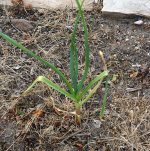 Native to central Asia and northeastern Iran, garlic is a herbaceous perennial and a member of the amaryllis family, Amaryllidaceae, that also includes onion, leek, and shallot. Growing from a bulb consisting of up to 20 cloves, the plant has 6-12 linear, flat, grass-like leaves up to 2′ long with a pointed tip. From July to September the bulb may produce a flowering stem up to 3′ tall carrying an umbel with pink to purple flowers surrounded by a brown sheath. Photo Credit Wikipedia
Native to central Asia and northeastern Iran, garlic is a herbaceous perennial and a member of the amaryllis family, Amaryllidaceae, that also includes onion, leek, and shallot. Growing from a bulb consisting of up to 20 cloves, the plant has 6-12 linear, flat, grass-like leaves up to 2′ long with a pointed tip. From July to September the bulb may produce a flowering stem up to 3′ tall carrying an umbel with pink to purple flowers surrounded by a brown sheath. Photo Credit Wikipedia
Garlic was cultivated in Mesopotamia 4,000 years ago and was used in ancient Egypt as both a culinary and medicinal herb.
Numbers 11. NIV As the Israelites wandered in the desert they complained about the lack of foods that they had eaten when living in Egypt.
5. ” We remember the fish we ate in Egypt at no cost—also the cucumbers, melons, leeks, onions and garlic.”
Garlic likes full sun and average, medium moist, well-drained soil in USDA Hardiness zones 3-10 but planting time varies greatly by zone. It is susceptible to several fungal and viral diseases as well as damage by nematodes, mites and insects. Propagation is usually by planting the cloves that make up the bulb but seed is possible.
The genus name, Allium, is the classical Latin name for garlic. The specific epithet, sativum, is the classical Latin word meaning planted and refers to the fact that garlic is cultivated.